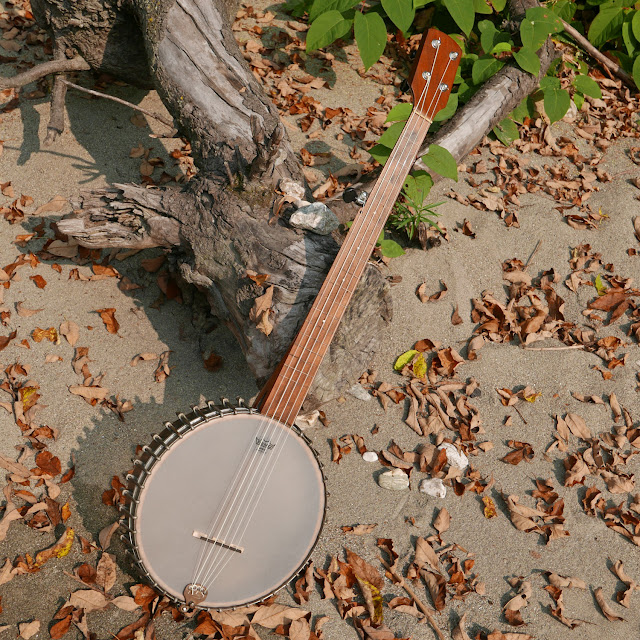1880s Buckbee 5-String Fretless Banjo
This is an 1880s Buckbee (made in New York) and, unlike most Buckbee makes, is actually stamped with the maker's mark (JHB) on the side of the heel. Most Buckbee instruments were made for sale under different brand names, so it's fun to see one actually bearing the mark.
Originally this was a fretted instrument, but upon taking the neck off and checking it out, I found that the neck had a pretty heavy backbow dipping down from the 7th fret on. It was more-or-less "straight" up to the 7th fret, but such neck wonkiness really makes for action/playability issues when frets are involved. My solution was to take back its design style a decade and outfit it with "flush frets" like a minstrel-style, 1870s banjo. I've worked on fretless Buckbees with the same style flush frets, so it's not like a severe crime to do so.
Work then included pulling the frets and filling the slots, planing the neck, sealing it, polishing the board, adding a new Remo Renaissance head (the pot is 10 3/4" in width), and giving it a good setup. It plays on-the-dot in the areas you're mostly playing on a fretless (up to the 9th fret), but then the action creeps up after that. This is actually an advantage for the old minstrel-ish styles, as the higher action where the "frets" ends makes it easy for clawhammer or "stroke style" period playing. Strings are "New Nylgut" with the plain low D string -- a lovely set and very slick for the fingers.
The rim is thin maple and has a spunover nickel-plated sleeve. The sleeve's edge is curled-over a hoop on the bottom but not on the top, so this doesn't have a tonering. Still, it's a pretty loud banjo for the time and projects nicely.
Excuse my shadow on the fretboard. I also added 4:1 geared tuners, too, to make life easy.
The neck and board are all one piece and made from walnut.
The tailpiece is simple and effective.
Buckbee necks are often put on with two screws (the ones to the side of the dowel), but I also added a third vintage screw to secure the bottom of the heel from lifting.
Don't you love that "boat heel" cut? Note the JHB on the side.
All the rim hardware is original save for one hook/nut which is a replacement from my bins and period, too.















Comments
What did you use to fill the fret slots? Also, have you ever had any trouble with those New Nylguts with the thicker, solid D string? A few flush fret banjos I've worked on tend to have a slight buzz when "fretted" on the D string no matter how straight I get the neck, even with moderately high action. Cheers, Warren
P.S., Like your new brand/format, though I kinda miss the orange!!